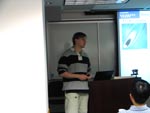Research Activities >
Programs >
Nonequilibrium Interface and Surface Dynamics 2007
|
|
A Mesoscopic View of Surface Diffusion
CSIC Building (#406),
Seminar Room 4122.
Directions: home.cscamm.umd.edu/directions
|
A Mesoscopic View of Surface Diffusion
Professor
Frank Meyer zu Heringdorf

Universitt Duisburg-Essen, Germany
|
|
Abstract:
Nanostructures on surfaces can either be formed by
means of nano-lithography, or by utilizing self-organisation
processes. While lithography is either an ex-situ
preparation or requires some cumbersome experimental
techniques, self-organisation relies on kinetic
effects, surface stress, and anisotropic diffusion.
Understanding self-organization requires
determination of the relative importance of these
parameters and an evaluation of the diffusion in the
system a challenging task, considering that often
myriads of atoms are involved in the structure
formation and very often the self-organization takes
place at elevated temperatures. Here, a new method
to image diffusion effects on the mesoscopic scale
will be presented: If Ag is deposited on Silicon
surfaces at ~500C, small and compact islands and
wires are formed on a Ag-reconstructed layer. If the
Ag flux is stopped, however, and the sample
temperature is slightly raised, Ag desorbs from the
reconstructed layer. The Ag islands and wires decay
while feeding silver into the surface in an attempt
to maintain the surface reconstruction. Over time, a
reconstructed region of higher Ag coverage can only
be preserved in the vicinity of the islands. The
perimeter of this region resembles a line of
constant coverage and represents a footprint of the
diffusion in the vicinity of the island.
Photoemission Electron Microscopy (PEEM) allows to
directly visualize the formation and decay of such
diffusion fields. The specific shape of the
diffusion field depends on the particular surface
and reflects the anisotropic character of the
diffusion as well. For the simple case of a circular
geometry, as observed on Si(001) and Si(111), a
continuum model links the observation to fundamental
diffusion parameters. |
|